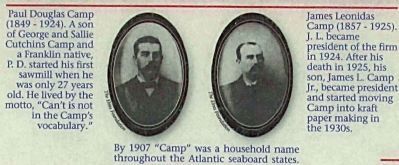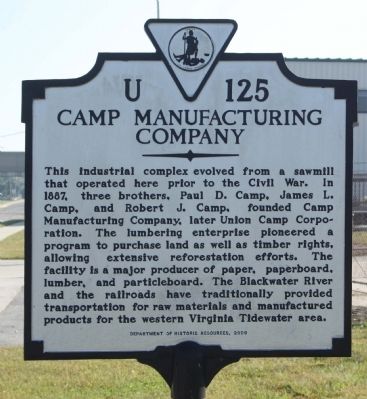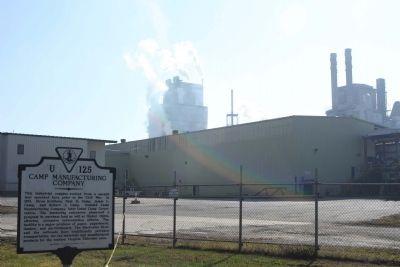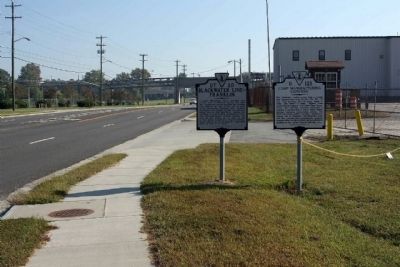Near Franklin in Isle of Wight County, Virginia — The American South (Mid-Atlantic)
Camp Manufacturing Company
Erected 2009 by Department of Historic Resources. (Marker Number U-125.)
Topics. This historical marker is listed in this topic list: Industry & Commerce. A significant historical year for this entry is 1887.
Location. 36° 40.9′ N, 76° 55.025′ W. Marker is near Franklin, Virginia, in Isle of Wight County. Marker is on Carrsville Highway (U.S. 58/258), on the right when traveling north. Located between East Street and Jamestown Lane (CR 691). Touch for map. Marker is at or near this postal address: 485 Carrsville Hwy, Franklin VA 23851, United States of America. Touch for directions.
Other nearby markers. At least 8 other markers are within walking distance of this marker. Blackwater Line - Franklin (here, next to this marker); Lyons State Theatre (approx. half a mile away); The Flood of September 1999 (approx. half a mile away); Franklin (approx. half a mile away); The Age of Gasoline (approx. half a mile away); Recovery and Progress (approx. half a mile away); War Comes to the Blackwater (approx. half a mile away); "Can't Is Not in the Camp's Vocabulary" (approx. half a mile away). Touch for a list and map of all markers in Franklin.
Related marker. Click here for another marker that is related to this marker. see the relationship wih marker shown.
Also see . . .
1. Union Camp Corporation, Wikipedia entry. The Camp Manufacturing Company was founded in 1887 by 3 local Camp brothers from Franklin, Virginia. Paul Douglas Camp (President), James Leonidas Camp (Vice-president) and Robert Judson Camp (secretary-treasurer) purchased a small sawmill on the outskirts of Franklin. (Submitted on October 28, 2013, by Mike Stroud of Bluffton, South Carolina.)
2. Franklin, Virginia - Industrialization and the Camp family. It was not until 1887 that Franklin began to see significant growth. Six brothers from the Camp family, with local roots, took
possession of a local sawmill. The sawmill was small and had been operating for several years alongside the Blackwater River With the Camp family's acquisition of the mill, it experienced 20 years of rapid growth under the leadership of Paul Douglas Camp (President), James Leonidas Camp (Vice-president) and Robert Judson Camp (Secretary-treasurer). At the end of this period, after a bout with near-bankruptcy, World War I brought the Camp family back to financial success, bringing along with it the city of Franklin. By 1918, "Tiny Franklin had become a booming wartime village. (Submitted on October 28, 2013, by Mike Stroud of Bluffton, South Carolina.)

"Can't Is Not in the Camp's Vocabulary" Marker,The Elms Foundation
4. Paul Douglas Camp. and James Leonidas Camp
(l) Paul Douglas Camp (1849-1924). A son of George and Sallie
Cutchins Camp and
a franklin native, P.D. started his first
sawmill when he was only 27 years
old. He lived by the motto, "Can't is not in the Camp's vocabulary."
(r) James Leonidas Camp (1857 - 1925), J.L. became president of the firm in 1924. After his death in 1925, his son, James L. Camp Jr., became president and started moving Camp into kraft paper making in the 1930s.
By 1907 Camp was a household name
throughout the Atlantic seaboard states.
old. He lived by the motto, "Can't is not in the Camp's vocabulary."
(r) James Leonidas Camp (1857 - 1925), J.L. became president of the firm in 1924. After his death in 1925, his son, James L. Camp Jr., became president and started moving Camp into kraft paper making in the 1930s.
throughout the Atlantic seaboard states.
Credits. This page was last revised on July 7, 2021. It was originally submitted on October 28, 2013, by Mike Stroud of Bluffton, South Carolina. This page has been viewed 1,306 times since then and 143 times this year. Photos: 1, 2, 3. submitted on October 28, 2013, by Mike Stroud of Bluffton, South Carolina. 4. submitted on December 28, 2011, by Mike Stroud of Bluffton, South Carolina.


